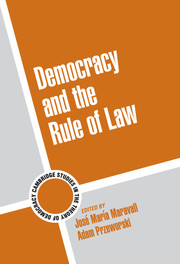Book contents
- Frontmatter
- Contents
- List of Contributors
- Acknowledgments
- Introduction
- Part I
- Part II
- 6 The Majoritarian Reading of the Rule of Law
- 7 How Can the Rule of Law Rule? Cost Imposition through Decentralized Mechanisms
- 8 Dictatorship and the Rule of Law: Rules and Military Power in Pinochet's Chile
- Part III
- Author Index
- Subject Index
7 - How Can the Rule of Law Rule? Cost Imposition through Decentralized Mechanisms
Published online by Cambridge University Press: 09 November 2009
- Frontmatter
- Contents
- List of Contributors
- Acknowledgments
- Introduction
- Part I
- Part II
- 6 The Majoritarian Reading of the Rule of Law
- 7 How Can the Rule of Law Rule? Cost Imposition through Decentralized Mechanisms
- 8 Dictatorship and the Rule of Law: Rules and Military Power in Pinochet's Chile
- Part III
- Author Index
- Subject Index
Summary
Let us begin with a definition that is widely agreed upon in the literature: we are in the presence of the “rule of law” when the rules defining permitted and forbidden actions are not discretionary decisions of an individual, but rather take the form of laws that discipline every citizen, regardless of his or her power or status. From this starting definition, it can be inferred that the “rule of law” faces an important political problem. This problem is not related to the difficulties rulers have in imposing and enforcing rules upon individual or collective actors. Indeed, with different degrees of efficiency, rulers have a varied and diverse repertoire of instruments they can use to make subjects obey the law (force, incentives, socialization, etc.). Rather, the central problem with the “rule of law” derives from the difficulties subjects have in making those who rule obey the law. Why should we expect that those who rule – that is, those who control the state resources – will obey the law? Why shouldn't we expect that they would use these resources to disobey the law? Therefore, an analysis of the rule of law implies answering what determines rulers' obedience to the law.
Authors such as Weingast, Przeworski, and Hardin have asserted that the rule of law will rule only if rulers and subjects conclude that it is in their interest to obey the law. That is, the rule of law will be successful if it becomes self-enforcing.
- Type
- Chapter
- Information
- Democracy and the Rule of Law , pp. 168 - 187Publisher: Cambridge University PressPrint publication year: 2003
- 22
- Cited by



